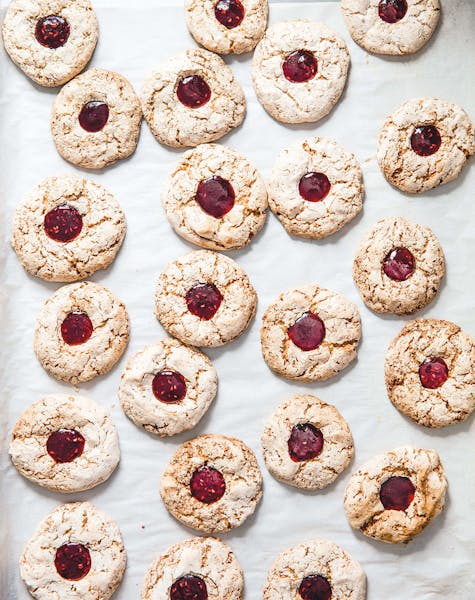There's simply no excuse not to bake, judging from the step-by-step, you-can-do-this books published this year.
Leading the pack is "Bread Illustrated" ($29.95) from the detail-obsessed folks at America's Test Kitchen. It is, as billed, illustrated and helpful for when you're looping kaiser rolls. But it also teaches with notes on "why this recipe works." Don't let the vast verbiage intimidate. You'll appreciate every word of instruction. A dozen "foolproof breads" set the stage.
Rye lovers have a treasure in "The Rye Baker" by Stanley Ginsberg (Norton, $35). Ginsberg is meticulous, with a level of science, history and research that almost overwhelms. Yet many bakers yearn for such well-informed detail, especially about a particular grain such as rye. Some 70 classic recipes illuminate rye's place in world baking. This is a book for a winter's mastery.
Adventure awaits with "Breaking Breads: A New World of Israeli Baking" by Uri Scheft (Artisan, $35). Whole chapters on challah and babka reveal a wide world beyond most bakery shelves. Creativity tweaks the classics with diversions such as beet hamantaschen. No matter your heritage, this collection will expand your horizons.
Tradition gets its due in "Classic German Baking" by Luisa Weiss (Ten Speed, $35). Weiss, who blogs from Berlin as the Wednesday Chef, collected a home baker's bible of German breads, sweets, savories and Christmas favorites. Hefty head notes for each recipe provide context while setting a conversational tone. An essential collection for Germans, and worthwhile for all.
Kate McDermott's Pie Camps in Port Angeles, Wash., attract scads of students. Now, here's the textbook. "Art of the Pie" (Countryman, $35) covers pies both sweet and savory, with a dozen crusts, including vegan and gluten-free. McDermott is chatty with a clear goal of instilling confidence, noting that even she rarely rolls out a crust that's perfectly round.
There still are the aspirational tomes. But even the 4½-pound "Patisserie at Home" by Melanie Dupuis and Anne Cazor (Harper Design, $50), with its Vanilla Vacherin and Tropezienne Tart, breaks down each recipe into doable steps. The authors even note "tricky aspects," which is charmingly frank. Not for novices, but catnip for the ambitious baker.
For stories with a side of recipes, Twenty-Five" (Andrews McMeel, $25) is a delight. The editors of Bake magazine profile 25 of "America's essential bakery and pastry artisans," among them locals Solveig Tofte of Sun Street Breads and Michelle Gayer of Salty Tart Bakery, standing tall with the likes of Dominique Ansel and Christina Tosi. Shuttle this one between the bedside table and your kitchen.
Haselnuss-Himbeer Makronen
Makes about 30.
Note: These hazelnut-raspberry macaroons are from "Classic German Baking.
•1 3/4 to 2 1/4 c. whole unskinned hazelnuts
• 2 egg whites
• 1/4 tsp. salt
• 3/4 c. sugar
• 1/2 c. raspberry jam
Directions
Preheat oven to 400 degrees.
Place hazelnuts on a baking sheet in a single layer and toast in oven for 15 minutes, or until fragrant. Lay a clean linen dishcloth flat on a work surface and dump the hot hazelnuts onto the cloth. Gather the cloth around the nuts and rub them together, massaging them until they are mostly skinned. Let cool completely.
Line 2 baking sheets with parchment paper. Place the nuts in a food processor and pulse until finely ground, but not so long that they turn into a paste.
Place the egg whites and salt in a spotlessly clean mixing bowl and whip until frothy. Slowly add the sugar and continue beating until the egg whites form soft peaks. The sugar will not be completely dissolved. Fold in all but 1/4 cup of the ground hazelnuts until well-combined. The mixture should be thick and hold its shape when dropped from a spoon. Add some of the remaining hazelnuts, if needed.
Using 2 small spoons, scoop out heaping teaspoonfuls of batter and mound on baking sheets, leaving about 1 inch between them. Place one sheet in the oven and bake for 10 minutes, until golden brown. Remove from oven and, with the back of a teaspoon, immediately press a well into the center of each cookie. Transfer to a rack and repeat with the remaining batch.
When all the cookies are on the rack and still warm, heat the jam in a small pot over medium heat until liquefied and let it bubble for 30 seconds. Spoon a little of the hot jam into the well of each cookie. Let the jam set and the cookies cool completely.
Store in an airtight container with parchment paper between the layers. The cookies will keep at least 1 week and up to 3 weeks.
Complex stories of migration are among the finalists for the Women's Prize for Fiction
Olympian Kristi Yamaguchi is 'tickled pink' to inspire a Barbie doll

After 4 decades in music and major vocal surgery, Jon Bon Jovi is optimistic and still rocking
Rom-com author Emily Henry knows the secret to having a healthy relationship with love

